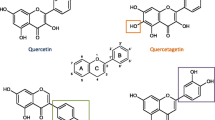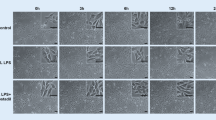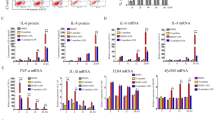Abstract
Infective endocarditis is caused by Streptococcus sanguinis present in dental plaque, which can induce inflammatory responses in the endocardium. The present study depicts research on the properties of apigenin in embryonic mouse heart cells (H9c2) treated with lipoteichoic acid (LTA) obtained from S. sanguinis. Interleukin-1β and cyclooxygenase (COX)-2 expression were detected by reverse transcriptase polymerase chain reaction. In addition, western blot assays and immuno-fluorescence staining were used to assess translocation of nuclear factor kappa beta (NF-κB), degradation of IκB, as well as activity of the mitogen activated protein kinases: extracellular signal-regulated kinase (ERK)1/2, p38, and c-Jun N-terminal kinase (JNK). Effect of apigenin on cell viability was equally assessed in other experimental series. Our results showed that apigenin blocked activation of ERK, JNK, and p38 in cardiomyocytes treated with LTA in a dose-dependent fashion. Moreover, apigenin showed no cytotoxic effects; it blocked NF-κB translocation and IκB degradation. Our findings suggested that apigenin possessed potential value in the treatment of infectious endocarditis.






Similar content being viewed by others
References
Carmichael J, DeGraff WG, Gazdar AF, Minna JD, Mitchell JB (1987) Evaluation of a tetrazolium-based semiautomated colorimetric assay: assessment of chemosensitivity testing. Cancer Res 47:936–941
Cognasse F, Hamzeh-Cognasse H, Chabert A, Jackson E, Arthaud CA, Garraud O, McNicol A (2014) Streptococcus sanguinis-induced cytokine and matrix metalloproteinase-1 release from platelets. BMC Immunol. 15:15–20
Damås JK, Aukrust P, Ueland T, Odegaard A, Eiken HG, Gullestad L, Sejersted OM, Christensen G (2001) Monocyte chemoattractant protein-1 enhances and interleukin-10 suppresses the production of inflammatory cytokines in adult rat cardiomyocytes. Basic Res Cardiol 96(4):345–352
De Moor CE, De Stoppelaar JD, van Houte J (1972) The occurrence of Streptococcus mutans and Streptococcus sanguis in the blood of endocarditis patients. Caries Res 6(1):73–74
Fort P, Marty L, Pichaczyk M, Sabrouty SE, Dani C, Jeanteur P, Blanchard JM (1985) Various rat adult tissues express only one major mRNA species from the glyceraldehyde-3-phosphate-dehydrogenase multigenic family. Nucleic Acids Res 13:1431–1442
Ge X, Kitten T, Chen Z, Lee SP, Munro CL, Xu P (2008a) Identification of Streptococcus sanguinis genes required for biofilm formation and examination of their role in endocarditis virulence. Infect Immun 76(6):2551–2559
Ge Y, Caufield PW, Fisch GS, Li Y (2008b) Streptococcus mutans and Streptococcus sanguinis colonization correlated with caries experience in children. Caries Res 42(6):444–448
Gutiérrez-Venegas G, Bando-Campos CG (2010) The flavonoids luteolin and quercetagetin inhibit lipoteichoic acid actions on H9c2 cardiomyocytes. Int Immunopharmacol 10(9):1003–1009
Gutiérrez-Venegas G, Cardoso-Jiménez P (2011) Lipoteichoic acid promotes nuclear accumulation of β-catenin via AKT in human gingival fibroblasts. Int Immunopharmacol 11(9):1278–1284
Gutiérrez-Venegas G, Alonso Luna O, Ventura-Arroyo JA, Hernández-Bermúdez C (2013) Myricetin suppresses lipoteichoic acid-induced interleukin-1 & #x03B2; and cyclooxygenase-2 expression in human gingival fibroblasts. Microbiol Immunol 57:849–856
Haffajee AD, Socransky SS, Patel MR, Song X (2008) Microbial complexes in supragingival plaque. Oral Microbiol Immunol 23(3):196–205
Hirschman JV (1987) Controversies in antimicrobial prophylaxis. Chemioterapia 6:202–207
Hodgson RJ, Lynch RJ, Watson GK, Labarbe R, Treloar R, Allison CJ (2001) A continuous culture biofilm model of cariogenic responses. Appl Microbiol 90(3):440–448
Hougee S, Sanders A, Faber J, Graus YM, van den Berg WB, Garssen J, Smit HF, Hoijer MA (2005) Decreased pro-inflammatory cytokine production by LPS-stimulated PBMC upon in vitro incubation with the flavonoids apigenin, luteolin or chrysin, due to selective elimination of monocytes/macrophages. Biochem Pharmacol 69(2):241–248
Kang JY, Nan X, Jin MS, Youn SJ, Ryu YH, Mah S, Han SH, Lee H, Paik SG, Lee JO (2009) Recognition of lipopeptide patterns by Toll-like receptor 2-Toll-like receptor 6 heterodimer. Immunity 31(6):873–888
Kang OH, Lee JH, Kwon DY (2011) Apigenin inhibits release of inflammatory mediators by blocking the NF-κB activation pathways in the HMC-1 cells. Immunopharmacol Immunotoxicol 33(3):473–479
Kao SJ, Lei HC, Kuo CT, Chang MS, Chen BC, Chang YC, Chiu WT, Lin CH (2005) Lipoteichoic acid induces nuclear factor-kappaB activation and nitric oxide synthase expression via phosphatidylinositol 3-kinase, Akt, and p38 MAPK in RAW 264.7 macrophages. Immunology 115(3):366-374
Kinane DF, Riggio MP, Walker KF, MacKenzie D, Shearer B (2005) Bacteraemia following periodontal procedures. J Clin Periodontol 32(7):708–713
Kowalski J, Samojedny A, Paul M, Pietsz G, Wilczok T (2005) Effect of apigenin, kaempferol and resveratrol on the expression of interleukin-1beta and tumor necrosis factor-alpha genes in J774.2 macrophages. Pharmacol Rep. 57(3):390–394
Liang YC, Huang YT, Tsai SH, Lin-Shiau SY, Chen CF, Lin JK (1999) Suppression of inducible cyclooxygenase and inducible nitric oxide synthase by apigenin and related flavonoids in mouse macrophages. Carcinogenesis 20(10):1945–1952
Liu LZ, Fang J, Zhou Q, Hu X, Shi X, Jiang BH (2005) Apigenin inhibits expression of vascular endothelial growth factor and angiogenesis in human lung cancer cells: implication of chemoprevention of lung cancer. Mol Pharmacol 68(3):635–643
Lockhart PB, Schmidtke MA (1994) Antibiotic considerations in medically compomised patients. Dent Clin North Am 38:381–402
Lockhart PB, Brennan MT, Kent ML, Norton HJ, Winrib DA (2004) Impact of amoxicillin prophylaxis on the incidence, nature and duration of bacteremia in children after intubation and dental procedures. Circulation 109:2878–2884
Lockhart PB, Brennan MT, Thornhill M, Michalowicz BS, Noll J, Bahrani-Mougeot FK, Sasser HC (2009) Poor oral hygiene as a risk factor for infective endocarditis-related bacteremia. J Am Dent Assoc 140(10):1238–1244
Lu HF, Chie YJ, Yang MS, Lee CS, Fu JJ, Yang JS, Tan TW, Wu SH, Ma YS, Ip SW, Chung JG (2010) Apigenin induces caspase-dependent apoptosis in human lung cancer A549 cells through Bax- and Bcl-2-triggered mitochondrial pathway. Int J Oncol 36(6):1477–1484
Mayo JA, Zhu H, Harty DW, Knox KW (1995) Modulation of glycosidase and protease activities by chemostat growth conditions in an endocarditis strain of Streptococcus sanguis. Oral Microbiol Immunol 10(6):342–348
Michelsen KS, Aicher A, Mohaupt M, Hartung T, Dimmeler S, Kirschning CJ, Schumann RR (2001) The role of toll-like receptors (TLRs) in bacteria-induced maturation of murine dendritic cells (DCS). Peptidoglycan and lipoteichoic acid are inducers of DC maturation and require TLR2. J Biol Chem 276(28):25680–25686
Nicholas C, Batra S, Vargo MA, Voss OH, Gavrilin MA, Wewers MD, Guttridge DC, Grotewold E, Doseff AI (2007) Apigenin blocks lipopolysaccharide-induced lethality in vivo and proinflammatory cytokines expression by inactivating NF-kappaB through the suppression of p65 phosphorylation. J Immunol. 179(10):7121–7127
Nishikawara F, Katsumura S, Ando A, Tamaki Y, Nakamura Y, Sato K, Nomura Y, Hanada NJ (2006) Correlation of cariogenic bacteria and dental caries in adults. Oral Sci. 48(4):245–251
Olsson J, van der Heijde Y, Holmberg K (1992) Plaque formation in vivo and bacterial attachment in vitro on permanently hydrophobic and hydrophilic surfaces. Caries Res 26(6):428–433
O’Neill PG, Ford-Hutchinson AW (1993) Expression of mRNA for cyclooxygenase-1 and cyclooxygenase-2 in human tissues. FEBS 330:156–160
Patil RH, Babu RL, Naveen Kumar M, Kiran Kumar KM, Hegde SM, Ramesh GT, Chidananda Sharma S (2015) Apigenin inhibits PMA-induced expression of pro-inflammatory cytokines and AP-1 factors in A549 cells. Mol Cell Biochem 403(1–2):95–106
Raso GM, Meli R, Di Carlo G, Pacilio M, Di Carlo R (2001) Inhibition of inducible nitric oxide synthase and cyclooxygenase-2 expression by flavonoids in macrophage J774A1. Life Sci 68(8):921–931
Schilling J, Lai L, Sambandam N, Dey CE, Leone TC, Kelly DP (2011) Toll-like receptor-mediated inflammatory signaling reprograms cardiac energy metabolism by repressing peroxisome proliferator-activated receptor γ coactivator-1 signaling. Circ Heart Fail. 4(4):474–482
Seo KH, Park MJ, Ra JE, Han SI, Nam MH, Kim JH, Lee JH, Seo WD (2014) Saponarin from barley sprouts inhibits NF-κB and MAPK on LPS-induced RAW 264.7 cells. Food Funct. 5(11):3005–3013
Shu M, Wong L, Miller JH, Sissons CH (2000) Development of multi-species consortia biofilms of oral bacteria as an enamel and root caries model system. Arch Oral Biol 45(1):27–40
Shukla S, Gupta S (2004) Suppression of constitutive and tumor necrosis factor alpha-induced nuclear factor (NF)-kappaB activation and induction of apoptosis by apigenin in human prostate carcinoma PC-3 cells: correlation with down-regulation of NF-kappaB-responsive genes. Clin Cancer Res 10(9):3169–3178
Sloley BD, Urichuk LJ, Morley P, Durkin J, Shan JJ, Pang PK, Coutts RT (2000) Identification of kaempferol as a monoamine oxidase inhibitor and potential Neuroprotectant in extracts of Ginkgo biloba leaves. J Pharm Pharmacol 52(4):451–459
Smolinski AT, Pestka JJ (2003) Modulation of lipopolysaccharide-induced proinflammatory cytokine production in vitro and in vivo by the herbal constituents apigenin (chamomile), ginsenoside Rb(1) (ginseng) and parthenolide (feverfew). Food Chem Toxicol 41(10):1381–1390
Stenudd C, Nordlund A, Ryberg M, Johansson I, Källestål C, Strömberg N (2001) The association of bacterial adhesion with dental caries. J Dent Res 80(11):2005–2010
Strom BL, Abrutyn E, Berlin JA, Kinman JL, Feldman RS, Stolley PD, Levison ME, Korzeniowski OM, Kaye D (2000) Risk factors for infective endocarditis: oral hygiene and nondental exposures. Circulation 102(23):2842–2848
Tang H, Tang Y, Li N, Shi Q, Guo J, Shang E, Duan JA (2014) Neuroprotective effects of scutellarin and scutellarein on repeatedly cerebral ischemia-reperfusion in rats. Pharmacol Biochem Behav 118:51–59
Tian Z, Liu SB, Wang YC, Li XQ, Zheng LH, Zhao MG (2013) Neuroprotective effects of formononetin against NMDA-induced apoptosis in cortical neurons. Phytother Res 27(12):1770–1775
van der Meer JTM, van Wijk W, Thompson J, Vandenbroucke JP, Valkenburg HA, Michel MF (1992) Efficacy of antibiotic prophylaxis for prevention of native-valve endocarditis. Lancet 339:135–139
Wang CN, Chi CW, Lin YL, Chen CF, Shiao YJ (2001) The neuroprotective effects of phytoestrogens on amyloid beta protein-induced toxicity are mediated by abrogating the activation of caspase cascade in rat cortical neurons. J Biol Chem 276(7):5287–5295
Wang M, Sankula R, Tsai BM, Meldrum KK, Turrentine M, March KL, Brown JW, Dinarello CA, Meldrum DR (2004) P38 MAPK mediates myocardial proinflammatory cytokine production and endotoxin-induced contractile suppression. Shock 21(2):170–174
Weinstock M, Grimm I, Dreier J, Knabbe C, Vollmer T (2014) Genetic variants in genes of the inflammatory response in association with infective endocarditis. PLoS ONE 9(10):e101501
Zhang FX, Kirschning CJ, Mancinelli R, Xu XP, Jin Y, Faure E, Mantovani A, Rothe M, Muzio M, Arditi M (1999) Bacterial lipopolysaccharide activates nuclear factor-kappaB through interleukin-1 signaling mediators in cultured human dermal endothelial cells and mononuclear phagocytes. J Biol Chem 274(12):7611–7614
Zhu L, Zhang Y, Fan J, Herzberg MC, Kreth J (2011) Characterization of competence and biofilm development of a Streptococcus sanguinisendocarditis isolate. Mol Oral Microbiol 26(2):117–126
Zijnge V, van Leeuwen MB, Degener JE, Abbas F, Thurnheer T, Gmür R, Harmsen HJ (2010) Oral biofilm architecture on natural teeth. PLoS ONE 5(2):e9321
Acknowledgments
We wish to express our thanks to the Dirección General de Asuntos del Personal Académico (DGAPA) PAPITT-IN 201816 for their financial support, and to Carmen Muñoz-Seca for editorial assistance.
Author information
Authors and Affiliations
Corresponding author
Rights and permissions
About this article
Cite this article
Gutiérrez-Venegas, G., González-Rosas, Z. Apigenin reduce lipoteichoic acid-induced inflammatory response in rat cardiomyoblast cells. Arch. Pharm. Res. 40, 240–249 (2017). https://doi.org/10.1007/s12272-016-0756-2
Received:
Accepted:
Published:
Issue Date:
DOI: https://doi.org/10.1007/s12272-016-0756-2




